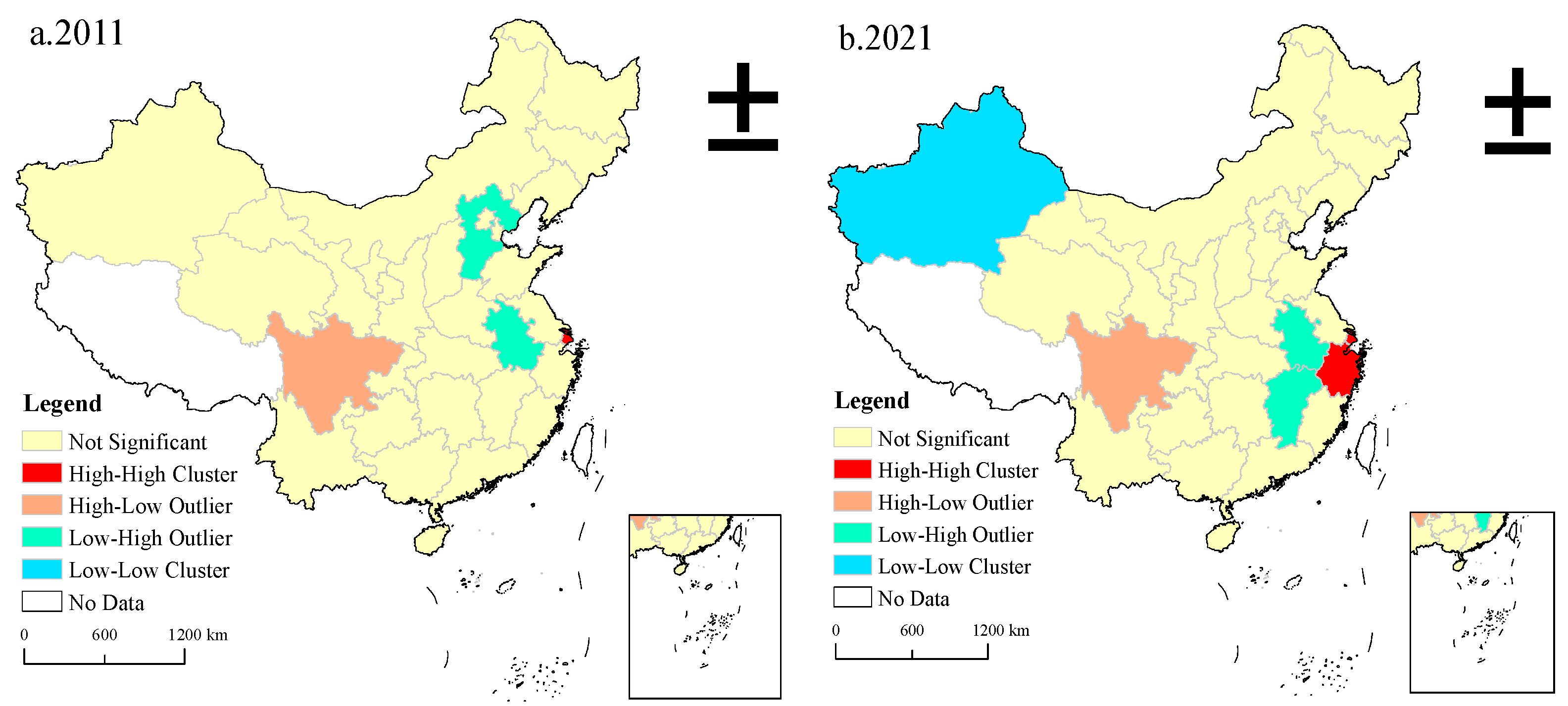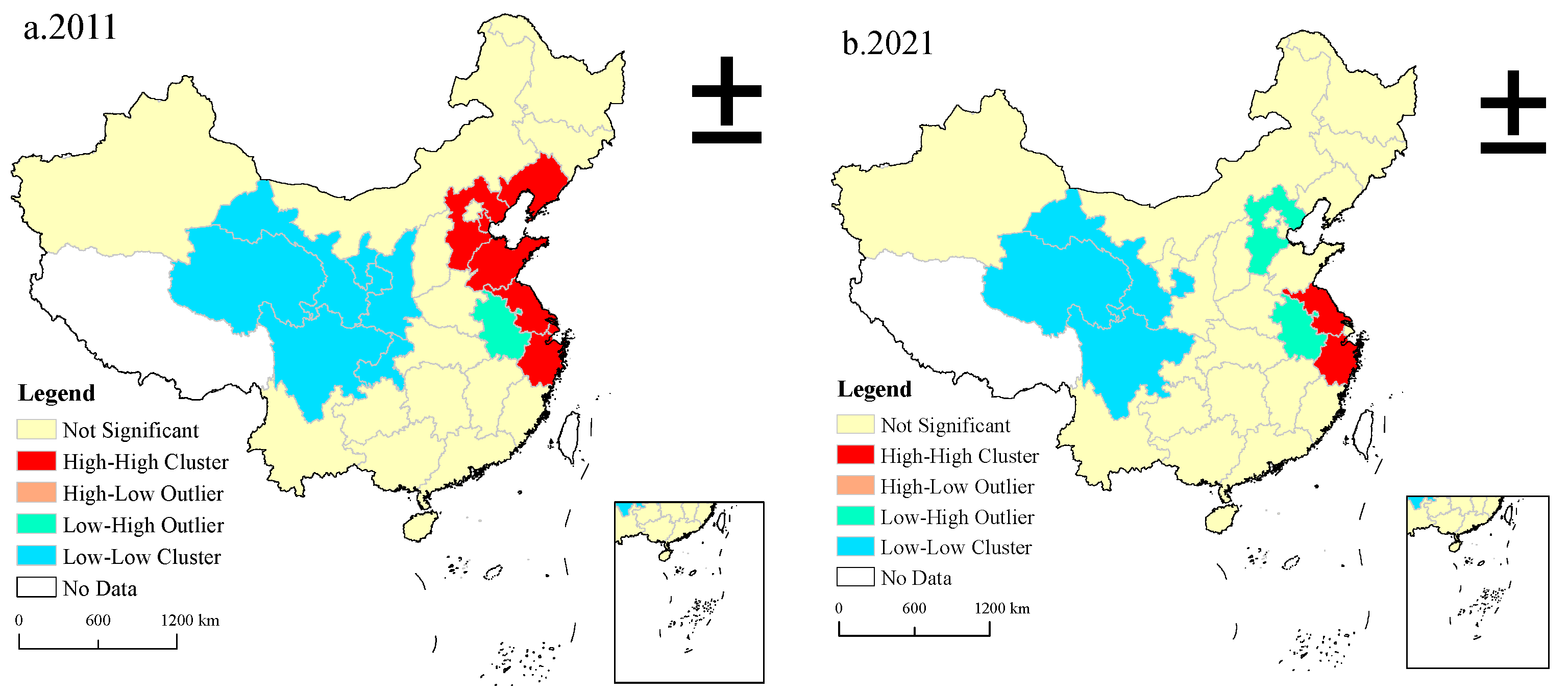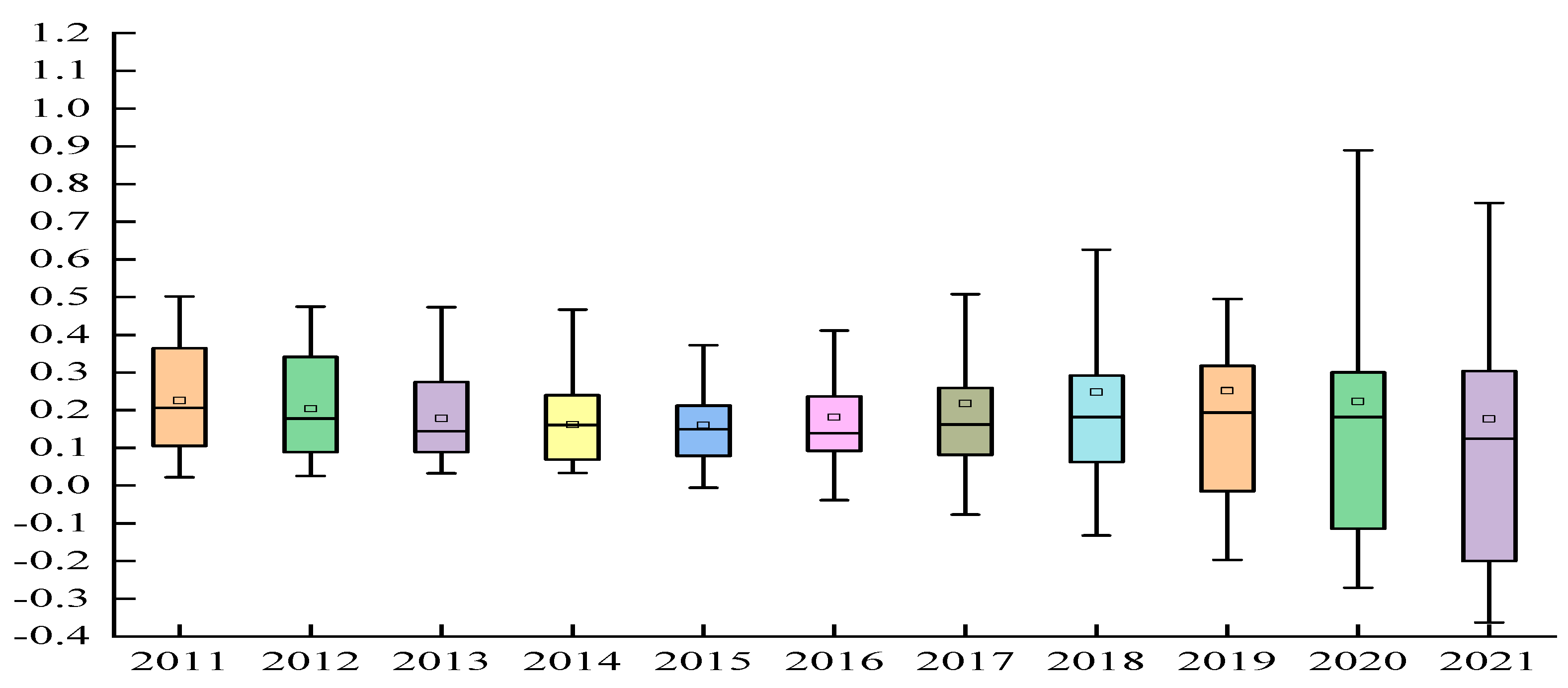The Spatiotemporal Impact of Digital Economy on High-Quality Agricultural Development: Evidence from China
Abstract
:1. Introduction
2. Literature Review
3. Model Construction and Indicator Description
3.1. Entropy-Weighted TOPSIS
- (1)
- The entropy weighting technique is employed to determine the weights of the indicators. The variable m denotes the sample size, while n represents the number of evaluation indicators. Additionally, k = 1/ln(m). Initially, the entropy values of each indicator are calculated using Equation (1), where “yi “represents the value of the j-th indicator in the i-th sample, and ej denotes the entropy value of each indicator, with 0 ≤ ej ≤ 1. Subsequently, the weights of each indicator are calculated based on the entropy values ej of each indicator, as shown in Equation (2), where Wj represents the weight of the j-th indicator.
- (2)
- The Euclidean distance is calculated, representing the distance of evaluation indicators from the ideal solution and the worst solution , as shown in Equations (3) and (4), where denotes the weighted normalized matrix of each indicator (), denotes the ideal solution (), and denotes the worst solution ().
- (3)
- The comprehensive evaluation index is calculated, specifically measuring the relative closeness of each evaluation object to the optimal solution.
3.2. Exploratory Spatial Data Analysis (ESDA)
3.3. GTWR Model
3.4. Indicator Description
3.4.1. Dependent Variable
3.4.2. Explanatory Variables
3.4.3. Selection of Control Variables
3.4.4. Source of Data
4. Results and Analysis
4.1. The Spatiotemporal Evolution of the Digital Economy and the High-Quality Development of Agricultural Economy
4.1.1. Time Series Feature Analysis
4.1.2. Spatial Distribution Characteristics Analysis
4.2. Spatial Correlation Analysis
4.2.1. Global Spatial Autocorrelation
4.2.2. Local Spatial Autocorrelation
4.3. Spatiotemporal Non-Stationarity Analysis
4.3.1. Prior Estimation of the Model
4.3.2. Model Testing and Selection
4.3.3. Robustness Test
4.3.4. Temporal Non-Stationarity Evolution of the Impact of the Digital Economy
4.3.5. Spatial Non-Stationarity Evolution of the Impact of the Digital Economy
5. Conclusions and Policy Implications
5.1. Conclusions
5.2. Policy Implications
Author Contributions
Funding
Institutional Review Board Statement
Informed Consent Statement
Data Availability Statement
Conflicts of Interest
References
- China’s 2022 Grain Production New Record High, Exceeding 650b Kg Mark for Eight Consecutive Years. Available online: https://www.globaltimes.cn/page/202212/1281648.shtml (accessed on 20 January 2024).
- Yao, W.; Sun, Z. The Impact of the Digital Economy on High-Quality Development of Agriculture: A China Case Study. Sustainability 2023, 15, 5745. [Google Scholar] [CrossRef]
- West, P.C.; Gerber, J.S.; Engstrom, P.M.; Mueller, N.D.; Brauman, K.A.; Carlson, K.M.; Cassidy, E.S.; Johnston, M.; MacDonald, G.K.; Ray, D.K.; et al. Leverage Points for Improving Global Food Security and the Environment. Science 2014, 345, 325–328. [Google Scholar] [CrossRef] [PubMed]
- Tian, T.; Li, L.; Wang, J. The Effect and Mechanism of Agricultural Informatization on Economic Development: Based on a Spatial Heterogeneity Perspective. Sustainability 2022, 14, 3165. [Google Scholar] [CrossRef]
- Ding, J.; Liu, W.; Wu, J. The Influence Factors and Mechanism of Rural Informationizational Spatial Effect. Areal Res. Dev. 2012, 31, 151–155. [Google Scholar]
- Tapscott, D. The Digital Economy: Promise and Peril in the Age of Networked Intelligence. Choice Rev. Online 1996, 33, 5199. [Google Scholar] [CrossRef]
- Xu, W.; Zhou, J.; Liu, C. The Impact of Digital Economy on Urban Carbon Emissions: Based on the Analysis of Spatial Effects. Geogr. Res. 2022, 41, 111–129. [Google Scholar] [CrossRef]
- Han, Z.; Zhao, J.; Wu, H. A Study on the Scale Measurement, Disequilibrium and Regional Differences of China’s Inter-Provincial Digital Economy. J. Quant. Tech. Econ. 2021, 38, 164–181. [Google Scholar]
- Wang, B.; Tian, J.; Cheng, L.; Hao, F.; Han, H.; Wang, S. Spatial Differentiation of Digital Economy and Its Influencing Factors in China. Sci. Geogr. Sin. 2018, 38, 859–868. [Google Scholar]
- Chen, Z.; Wei, Y.; Shi, K.; Zhao, Z.; Wang, C.; Wu, B.; Qiu, B.; Yu, B. The Potential of Nighttime Light Remote Sensing Data to Evaluate the Development of Digital Economy: A Case Study of China at the City Level. Comput. Environ. Urban. Syst. 2022, 92, 101749. [Google Scholar] [CrossRef]
- Zhang, Y. The Development Strategy and Main Tasks of the Digital Economy Driving the Industrial Structure to the Middle and High End. Econ. Rev. 2018, 9, 85–91. [Google Scholar] [CrossRef]
- Zhang, Y.; Wang, M.; Liu, T. Spatial Effect of Digital Economy on High-Quality Economic Development in China and Its Influence Path. Geogr. Res. 2022, 41, 1826–1844. [Google Scholar] [CrossRef]
- Jing, W.; Sun, B. Digital Economy Promotes High-Quality Economic Development: A Theoretical Analysis Framework. Economist 2019, 2, 66–73. [Google Scholar] [CrossRef]
- Cao, Z. Research on the New Manufacturing Model to Promote High-Quality Development of China’s Industry under the Background of Digital Economy. Theor. Investig. 2018, 2, 99–104. [Google Scholar] [CrossRef]
- Su, Z.; Zheng, Y.; Guo, L. Impact of the Digital Economy on the Carbon Efficiency of the Tourism Industry and Its Threshold Effect. China Popul. Resour. Environ. 2023, 33, 69–79. [Google Scholar] [CrossRef]
- Ju, X.; Xue, Y.; Xi, B.; Jin, T.; Xu, Z.; Gao, S. Establishing an Agro-Ecological Compensation Mechanism to Promote Agricultural Green Development in China. J. Resour. Ecol. 2018, 9, 426–433. [Google Scholar] [CrossRef]
- Krugman, P. The Myth of Asia’s Miracle. Foreign Aff. 1994, 73, 62–78. [Google Scholar] [CrossRef]
- Johnson, D.G. Agriculture and the Wealth of Nations. Am. Econ. Rev. 1997, 87, 1–12. [Google Scholar]
- Feng, Y.; Zhong, S.; Li, Q.; Zhao, X.; Dong, X. Ecological Well-Being Performance Growth in China (1994–2014): From Perspectives of Industrial Structure Green Adjustment and Green Total Factor Productivity. J. Clean. Prod. 2019, 236, 117556. [Google Scholar] [CrossRef]
- Kalirajan, K.P.; Obwona, M.B.; Zhao, S. A Decomposition of Total Factor Productivity Growth: The Case of Chinese Agricultural Growth before and after Reforms. Am. J. Agric. Econ. 1996, 78, 331–338. [Google Scholar] [CrossRef]
- Deng, F.; Jia, S.; Ye, M.; Li, Z. Coordinated Development of High-Quality Agricultural Transformation and Technological Innovation: A Case Study of Main Grain-Producing Areas, China. Environ. Sci. Pollut. Res. 2022, 29, 35150–35164. [Google Scholar] [CrossRef]
- Li, H.; Zhang, J.; Luo, S.; He, K. Impact and Mechanism of Agricultural Technology Innovation on Agricultural Development Quality—Empirical Evidence from the Spatial Perspective. RD Manag. 2021, 33, 1–15. [Google Scholar] [CrossRef]
- Fan, S.; Pardey, P.G. Research, Productivity, and Output Growth in Chinese Agriculture. J. Dev. Econ. 1997, 53, 115–137. [Google Scholar] [CrossRef]
- Zhu, Q.; Bai, J.; Peng, C.; Zhu, C. Do Information Communication Technologies Improve Agricultural Productivity? Chin. Rural. Econ. 2019, 4, 22–40. [Google Scholar]
- Qin, Q.; Guo, H.; Zeng, Y. The Mechanism and Countermeasures of Digital Empowerment to Promote Rural Revitalization. J. Jiangsu Univ. Soc. Sci. Ed. 2021, 23, 22–33. [Google Scholar] [CrossRef]
- Gao, D.; Lyu, X. Agricultural Total Factor Productivity, Digital Economy and Agricultural High-Quality Development. PLoS ONE 2023, 18, e0292001. [Google Scholar] [CrossRef] [PubMed]
- Zhou, Q.; He, A. High Quality Development of the Yellow River Basin Empowered by Digital Economy. Econ. Probl. 2020, 11, 8–17. [Google Scholar] [CrossRef]
- Zhou, Q.; Li, X. Digital Economy and High-Quality Agricultural Development Internal Mechanism and Empirical Analysis. Reform. Econ. Syst. 2022, 6, 82–89. [Google Scholar]
- Zhang, Y.; Ji, M.; Zheng, X. Digital Economy, Agricultural Technology Innovation, and Agricultural Green Total Factor Productivity. SAGE Open 2023, 13, 21582440231194388. [Google Scholar] [CrossRef]
- Wang, S.; Chen, Y. How Does Digital Inclusive Finance Promote the High-Quality Development of Agriculture? On Intermediary and Threshold Mechanism. J. Manag. 2022, 35, 72–87. [Google Scholar] [CrossRef]
- Tang, Y.; Chen, M. The Impact of Agricultural Digitization on the High-Quality Development of Agriculture: An Empirical Test Based on Provincial Panel Data. Land 2022, 11, 2152. [Google Scholar] [CrossRef]
- Huang, B.; Wu, B.; Barry, M. Geographically and Temporally Weighted Regression for Modeling Spatio-Temporal Variation in House Prices. Int. J. Geogr. Inf. Sci. 2010, 24, 383–401. [Google Scholar] [CrossRef]
- Fotheringham, A.S.; Brunsdon, C.; Charlton, M. Geographically Weighted Regression: The Analysis of Spatially Varying Relationships; John Wiley & Sons: Hoboken, NJ, USA, 2003; ISBN 0-470-85525-8. [Google Scholar]
- Fotheringham, A.S.; Crespo, R.; Yao, J. Geographical and Temporal Weighted Regression (GTWR): Geographical and Temporal Weighted Regression. Geogr. Anal. 2015, 47, 431–452. [Google Scholar] [CrossRef]
- Liu, R.; Guo, T. Construction and Application of the High-quality Development Index——Also on the High-quality Development of Northeast China’s Economy. J. Northeast. Univ. Soc. Sci. 2020, 22, 31–39. [Google Scholar] [CrossRef]
- Wang, J.; Shi, M.; Li, Z. Digital Economy Promotes High-Quality Agricultural Development: Internal Mechanism and Empirical Evidence. J. Univ. Financ. Econ. 2023, 36, 78–89. [Google Scholar] [CrossRef]
- Xin, L.; An, X. Construction and Empirical Analysis of Agricultural High-Quality Development Evaluation System in China. Econ. Rev. 2019, 5, 109–118. [Google Scholar] [CrossRef]
- Ye, F.; Qin, S.; Nisar, N.; Zhang, Q.; Tong, T.; Wang, L. Does Rural Industrial Integration Improve Agricultural Productivity? Implications for Sustainable Food Production. Front. Sustain. Food Syst. 2023, 7, 1191024. [Google Scholar] [CrossRef]
- Xiang, W.; Zhu, K.; Teo, B.S.-X.; Zunirah, M.T. Development Experience and Future Prospects of the Integration of Three Rural Industries in China. Asian J. Soc. Sci. Stud. 2022, 7, 98. [Google Scholar] [CrossRef]
- Zhang, L.; Wen, T.; Liu, Y. Integrated Development of Rural Industries and Farmers’ Income Growth: Theoretical Mechanism and Empirical Determination. J. Southwest Univ. 2020, 46, 42–56. [Google Scholar]
- Liu, T.; Li, J.; Huo, J. Spatial-Temporal Pattern and Influencing Factors of High-Quality Agricultural Development in China. J. Arid. Land Resour. Environ. 2020, 34, 1–8. [Google Scholar] [CrossRef]
- Sun, Y.; Tang, X. The Impact of Digital Inclusive Finance on Sustainable Economic Growth in China. Financ. Res. Lett. 2022, 50, 103234. [Google Scholar] [CrossRef]
- Attridge, S.; Engen, L. Blended Finance in the Poorest Countries: The Need for a Better Approach; ODI Report: London, UK, 2019. [Google Scholar]
- Havemann, T. Landscape Report: Blended Finance for Agriculture; SAFIN: Zürich, Switzerland, 2019. [Google Scholar]
- Havemann, T.; Negra, C.; Werneck, F. Blended Finance for Agriculture: Exploring the Constraints and Possibilities of Combining Financial Instruments for Sustainable Transitions. Agric. Hum. Values 2020, 37, 1281–1292. [Google Scholar] [CrossRef] [PubMed]







| Primary Indicators | Secondary Indicators | Indicator Description | Characteristics | Weight of Indicators |
|---|---|---|---|---|
| Basic development | Grain yield per unit area | Total area of grain cultivation/seeding area | + | 0.01509 |
| Level of agricultural mechanization | Total agricultural machinery power/arable land area | + | 0.04114 | |
| Quality improvement | Labor productivity | The combined value of animal husbandry, forestry, and agriculture/number of primary industry employees | + | 0.03242 |
| Land productivity | Total value of agricultural production/crop sown area | + | 0.04593 | |
| Rural per capita income | Average income per person in rural family | + | 0.0441 | |
| Index of agricultural industrial structure adjustment | Value of agricultural products/the combined value of animal husbandry, forestry, and agriculture | + | 0.00605 | |
| Engel coefficient of rural residents | Engel coefficient of rural populations | − | 0.01028 | |
| Urban/rural income ratio | Urban dwellers’ per capita disposable income/rural dwellers’ per capital disposable income | − | 0.01192 | |
| Urban/rural consumption ratio | Urban dwellers’ per capita consumption expenses/rural dwellers’ per capita consumption expenses | − | 0.01106 | |
| Integrated development | The proportion of added value of the tertiary industry | Value added of the tertiary industry/value added of the primary industry | + | 0.31082 |
| Proportion of agricultural product processing industry | The agricultural product manufacturing sector’s operating income/value of agricultural products | + | 0.11777 | |
| Proportion of agriculture, forestry, animal husbandry | The combined value of animal husbandry, forestry, and agriculture/the combined value of primary sector | + | 0.07435 | |
| New quality development | Degree of plastic film usage in agriculture | Amount of plastic film used in agriculture/crop sown area | − | 0.0058 |
| Level of fertilizer usage in agriculture | Amount of fertilizer used in agriculture/crop sown area | − | 0.00937 | |
| Level of pesticide usage | Quantity of pesticide applied/crop sown area | − | 0.01644 | |
| Forest coverage rate | Forest area/cultivated land area | + | 0.04131 | |
| Rate of efficient irrigation | Area of efficient irrigation/cultivated land area | + | 0.03811 | |
| Shared development | Local financial education level | Local fiscal education expenditure | + | 0.04487 |
| Financial support for agriculture | Expenditure on agricultural, forestry, and water affairs | + | 0.03527 | |
| Level of agricultural openness | Total agricultural product import and export trade/GDP | + | 0.08789 |
| Primary Indicators | Secondary Indicators | Characteristics | Weight of Indicators |
|---|---|---|---|
| Digital infrastructure | Ports available for broadband internet connectivity (in tens of thousands) | + | 0.02861 |
| Long-distance optical cable length (in ten thousand kilometers) | + | 0.01764 | |
| Rate of mobile phone ownership per one hundred individuals | + | 0.01178 | |
| Domain name count (in ten thousands) | + | 0.06488 | |
| Digital industrialization | Total postal business volume (in CNY 100 millions) | + | 0.09503 |
| Total telecommunications business volume (in CNY ten billions) | + | 0.05837 | |
| Scale of software product revenue | + | 0.09107 | |
| Number of workers in the information service sector (in ten thousands) | + | 0.05252 | |
| Expenditure on research and development (in CNY ten billions) | + | 0.48609 | |
| Number of patent applications (in thousands) | + | 0.06043 | |
| Inclusive digital finance | Extent of inclusive digital finance coverage | + | 0.01268 |
| Depth of inclusive digital finance usage | + | 0.01113 | |
| Degree of digitization of inclusive digital finance | + | 0.00978 |
| Year | High-Quality Agricultural Development | Digital Economy | ||||
|---|---|---|---|---|---|---|
| Moran’s I | Z Value | p Value | Moran’s I | Z Value | p Value | |
| 2011 | 0.350 | 5.132 | 0.000 | 0.204 | 3.240 | 0.001 |
| 2012 | 0.340 | 5.080 | 0.000 | 0.260 | 3.981 | 0.000 |
| 2013 | 0.385 | 5.628 | 0.000 | 0.212 | 5.108 | 0.000 |
| 2014 | 0.374 | 5.480 | 0.000 | 0.198 | 3.210 | 0.001 |
| 2015 | 0.374 | 5.599 | 0.000 | 0.192 | 3.151 | 0.002 |
| 2016 | 0.360 | 5.529 | 0.000 | 0.262 | 4.078 | 0.000 |
| 2017 | 0.335 | 5.330 | 0.000 | 0.341 | 5.093 | 0.000 |
| 2018 | 0.322 | 5.177 | 0.000 | 0.269 | 4.237 | 0.000 |
| 2019 | 0.317 | 5.158 | 0.000 | 0.215 | 3.492 | 0.000 |
| 2020 | 0.321 | 5.220 | 0.000 | 0.135 | 2.389 | 0.017 |
| 2021 | 0.335 | 5.417 | 0.000 | 0.186 | 3.061 | 0.002 |
| Variables | VIF | 1/VIF | LLC Test | IPS Test (Level) | IPS Test (1st Difference) |
|---|---|---|---|---|---|
| ng | - | - | −12.161 *** | −3.7503 *** | −7.3356 *** |
| dig | 1.83 | 0.545 | −13.939 *** | −5.7094 *** | −6.7229 *** |
| ur | 2.60 | 0.384 | −5.772 *** | −2.4742 *** | −3.3516 *** |
| edu | 1.77 | 0.565 | −13.367 *** | −4.8112 *** | −7.9699 *** |
| jgh | 1.61 | 0.622 | −6.073 *** | −0.4750 | −4.8186 *** |
| open | 1.90 | 0.525 | −4.196 *** | 0.9432 | −5.9407 *** |
| old | 1.24 | 0.806 | −13.104 *** | −4.3520 *** | −7.5757 *** |
| Mean VIF | 1.83 | - | - |
| Parameters | OLS | TWR | GWR | GTWR |
|---|---|---|---|---|
| R-squared | 0.763 | 0.845 | 0.924 | 0.961 |
| Adjusted R-squared | - | 0.842 | 0.922 | 0.960 |
| AICc | −746.374 | −846.323 | −1025.1 | −1153.03 |
| RSS | 1.929 | 1.270 | 0.624 | 0.319 |
| Bandwidth | - | 0.196 | 0.115 | 0.115 |
| Parameters | dig1 | dig2 | dig3 | |||
|---|---|---|---|---|---|---|
| OLS | GTWR | OLS | GTWR | OLS | GTWR | |
| R-squared | 0.769 | 0.976 | 0.753 | 0.945 | 0.772 | 0.974 |
| Adjusted R-squared | 0.975 | 0.944 | 0.973 | |||
| AICc | −1257.9 | −1770.6 | −1235.9 | −1616.12 | −1260.7 | 1735.5 |
| RSS | 0.409 | 0.042 | 0.437 | 0.098 | 0.406 | 0.047 |
| Bandwidth | 0.011 | 0.017 | 0.012 | |||
Disclaimer/Publisher’s Note: The statements, opinions and data contained in all publications are solely those of the individual author(s) and contributor(s) and not of MDPI and/or the editor(s). MDPI and/or the editor(s) disclaim responsibility for any injury to people or property resulting from any ideas, methods, instructions or products referred to in the content. |
© 2024 by the authors. Licensee MDPI, Basel, Switzerland. This article is an open access article distributed under the terms and conditions of the Creative Commons Attribution (CC BY) license (https://creativecommons.org/licenses/by/4.0/).
Share and Cite
Li, Q.; Liu, Z. The Spatiotemporal Impact of Digital Economy on High-Quality Agricultural Development: Evidence from China. Sustainability 2024, 16, 2814. https://doi.org/10.3390/su16072814
Li Q, Liu Z. The Spatiotemporal Impact of Digital Economy on High-Quality Agricultural Development: Evidence from China. Sustainability. 2024; 16(7):2814. https://doi.org/10.3390/su16072814
Chicago/Turabian StyleLi, Qi, and Zhijiao Liu. 2024. "The Spatiotemporal Impact of Digital Economy on High-Quality Agricultural Development: Evidence from China" Sustainability 16, no. 7: 2814. https://doi.org/10.3390/su16072814
APA StyleLi, Q., & Liu, Z. (2024). The Spatiotemporal Impact of Digital Economy on High-Quality Agricultural Development: Evidence from China. Sustainability, 16(7), 2814. https://doi.org/10.3390/su16072814







